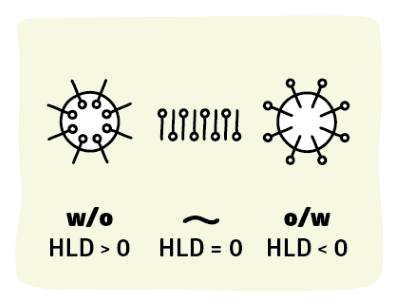Interfacial Tension
Quick Start
Very often, we want to control the Interfacial Tension, IFT, and we are especially interested in getting a super-low IFT for detergency, oil recovery and more.
The calculation is straightforward in HLD-NAC but the app is a bit more complicated because you can control your IFT via temperature, EACN, Cc or salinity, and the effects can be different for ethoxylates, ionics or other (e.g. sugar- or glycerol-based)
The fact that it's slightly complicated is an indication of the power of the approach. If you select non-Log, you find that the curve is quite boring. But in Log mode you see the desirable areas where IFT becomes super-low.
IFT
 The solubility page showed the solubility rising to a maximum near the Type III point. The other change, equally important, is the reduction in the IFT (interfacial tension).
The solubility page showed the solubility rising to a maximum near the Type III point. The other change, equally important, is the reduction in the IFT (interfacial tension).
This isn't a small drop - it is orders of magnitude reduction to very low levels. At this point the oil and water can intermingle with very little energetic cost. This is beneficial for creating emulsions with very little mixing energy (the so-called PIT technique for ethoxylate emulsions relies on this trick) and is crucial to extracting oil from wells by pumping an aqueous surfactant through the pores in the oil-bearing rocks. One of the key drivers for the development of HLD theory was the need to predict these ultra-low IFTs for maximum oil extraction.
It is a little-known fact that much of high-quality surfactant-based cleaning relies on the tuning of surfactant, temperature and salinity to reach this low IFT for easy removal of oil-based soils. The idea that surfactants help cleaning by "reducing the surface tension of the water" is hopelessly wrong. If it were correct then just about any surfactant could clean any oil. The surface tension is almost irrelevant (because all surfactants can reduce it adequately), it's the IFT which is critical and why different surfactants are required for different oils at different temperatures.
Finally, the low IFT can be used to separate emulsions. The idea is used extensively in separation of oils from water, where the oil might be a crude oil from the ground or oil extracted from coconuts.
If low IFT is so useful then maybe it's a good idea to be able to calculate it. That's what this page does. Everything is the same as before. The only difference is that instead of plotting solubility on a linear scale the default is to plot IFT on a log scale. This brings out the strong (and significant) differences between IFT=0.01 and IFT=0.001. By selecting the non-log option the broad parabolic curve fails to show large differences because on a linear scale it is hard to see the difference between 0.01 and 0.001. As with Solubility, the ξ parameter is an estimated value. The novel required input is N kT. This is the rigidity of the surfactant layer is in terms of Boltzmann constants, kT. A typical value for an ionic is 1kT (the interfaces are relatively flexible) and for an ethoxylate it is 4kT (they are more rigid which gives more stable interfaces, but larger IFTs).
IFT is calculated simply from the given rigidity Er and the drop radius R which in turn is calculated via NAC theory:
IFT = Er/(4πR²)


